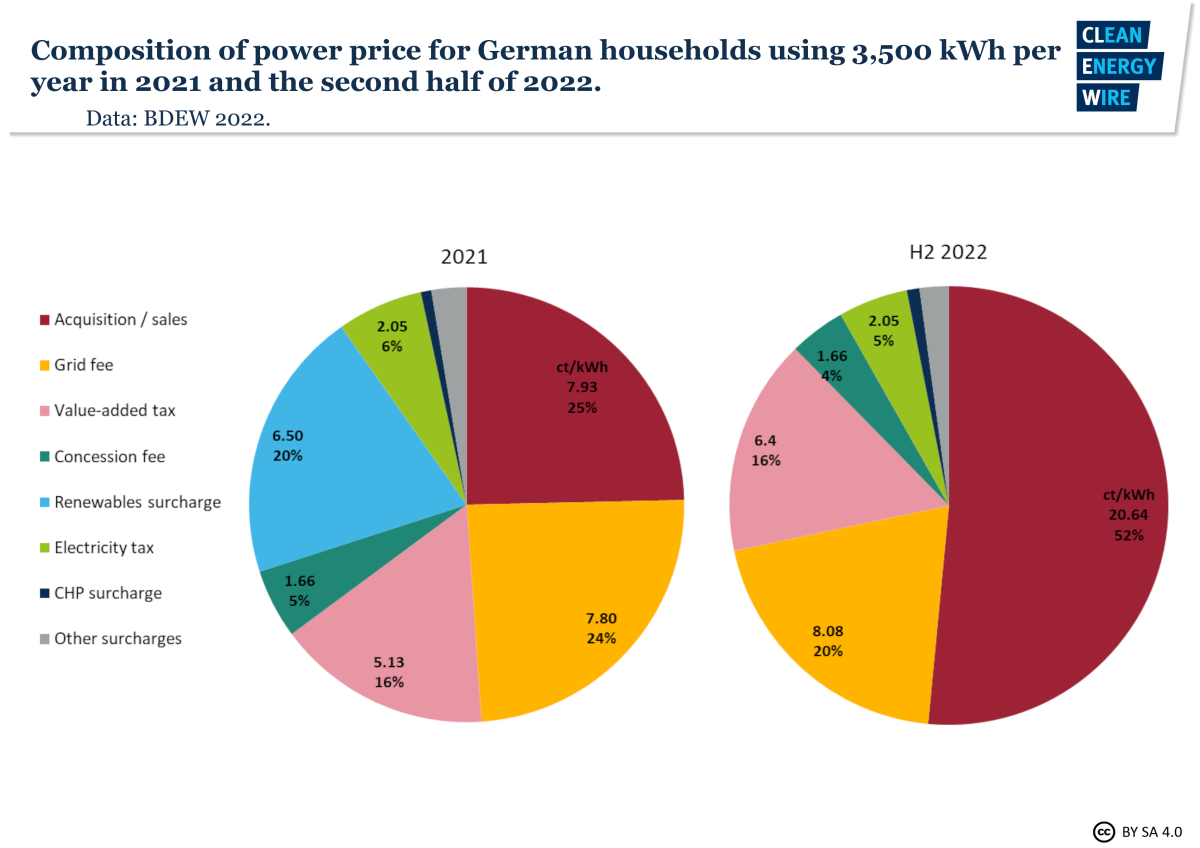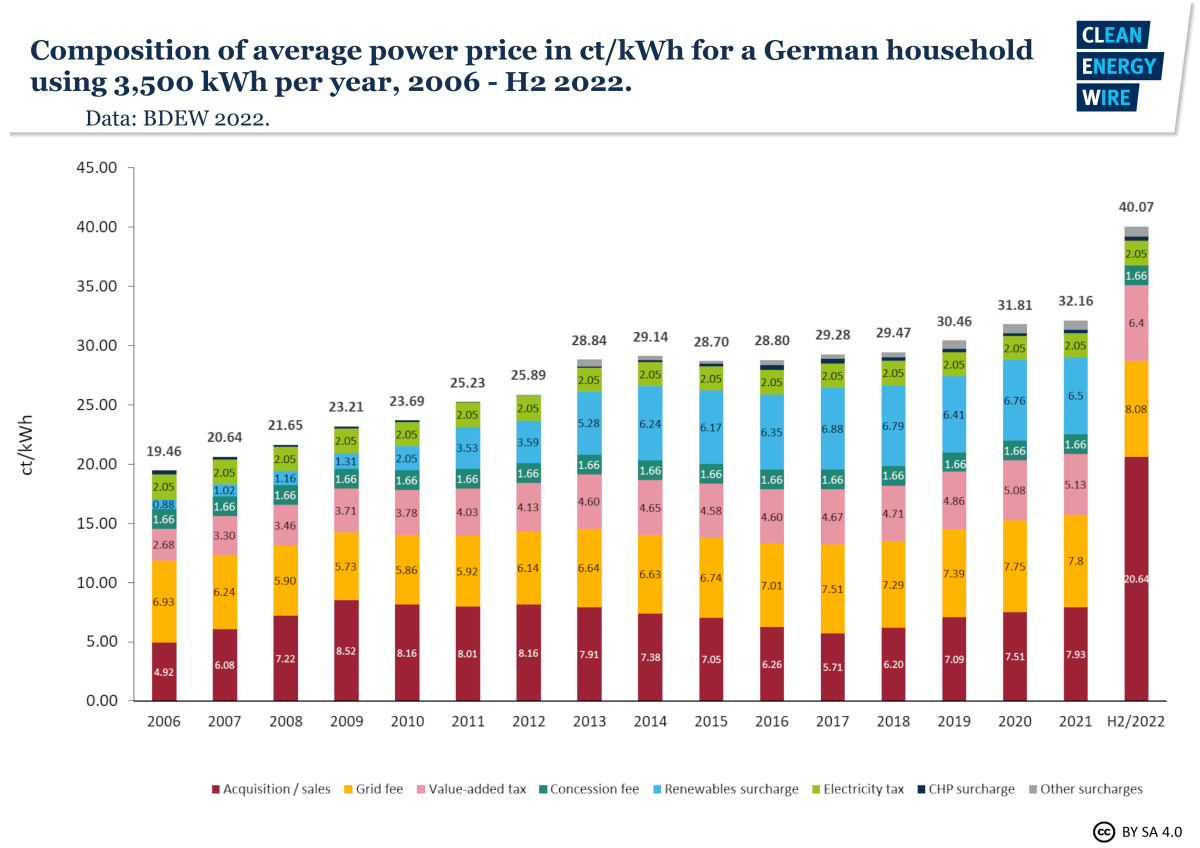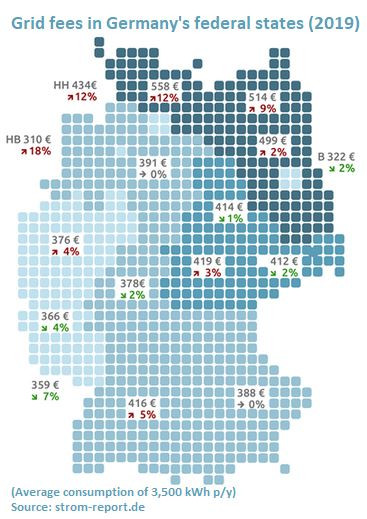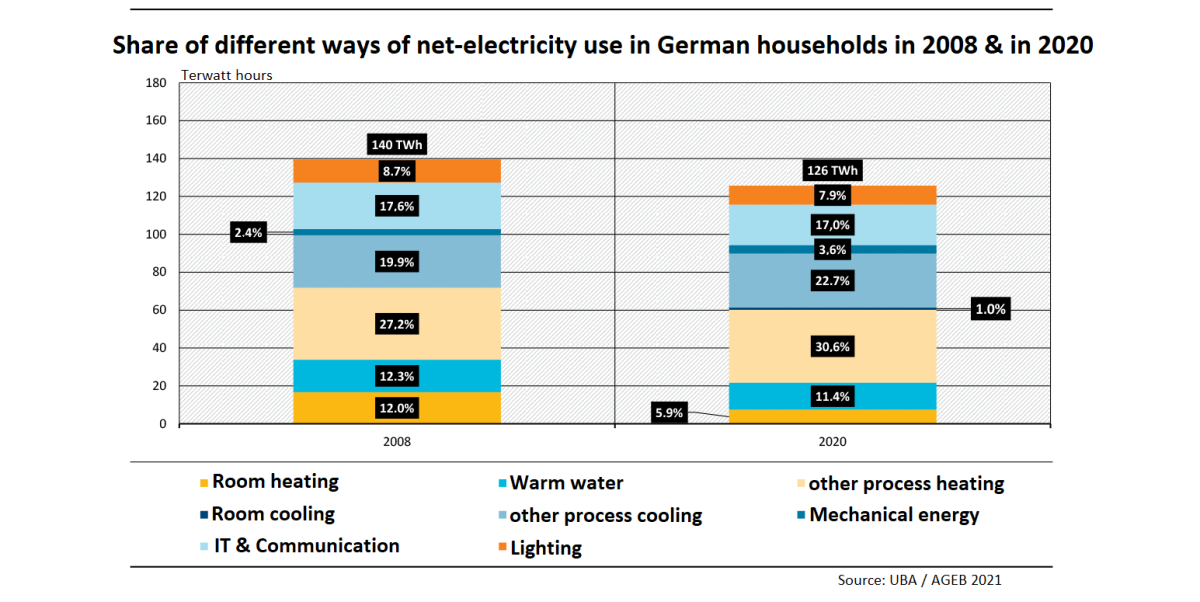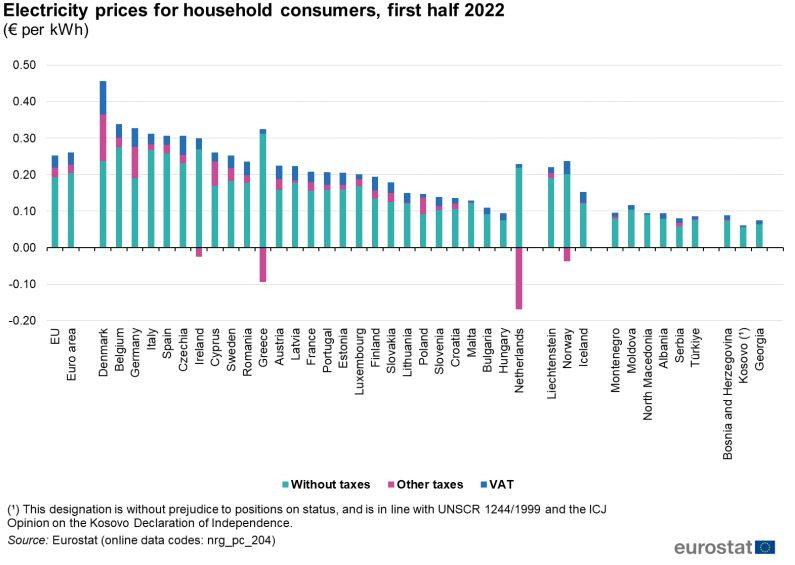What German households pay for electricity
Please note: Most German households use heating oil or natural gas for heating, for which they receive separate bills. This factsheet exclusively looks at eletrictiy bills.
Electricity price components
The energy crisis that threw European energy markets in turmoil in 2022 has caused wholesale power prices in Germany to spike, reaching unprecedented levels throughout the year. Prices began to tick upward by the end of 2021 due to rising demand globally, as more countries emerged from the Covid-19 pandemic. The crisis then intensified as a result of Russia’s war on Ukraine. The ensuing trade conflict between Russia and other European nations led to a shortage of fossil fuels in the EU, causing prices for electricity to shoot up - especially in Germany, where gas plants still account for a substantial part of electricity generation. Moreover, prices for CO2 emissions allowances in the European trading system (ETS) more than tripled between 2020 and 2022, putting further pressure on electricity costs.
Households in Germany on average paid 40.07 cents per kilowatt hour (kWh) in the second half of 2022, compared to 32.16 ct/kWh in the previous year. The increase was mostly caused by higher procurement and retailing costs for electricity, which according to the German Association of Energy and Water Industries (BDEW) rose by 160 percent compared with 2021. At the same time, the price increase for households was dampened by the abolition of Germany’s renewable energy levy, which stood at 3.72 ct/kWh, before being eliminated in mid-2022.
The average household with an annual electricity consumption of 3,500 kWh was charged 116.86 euros per month in the second half of 2022, the BDEW said. In nominal terms, this corresponds to a total price increase of 134 percent compared to 1998, when the internal European energy market was introduced. However, the real terms increase, which is calculated by adjusting the price increase for inflation, has been considerably lower. Compared to the year before, electricity prices in December 2022 were 37 percent higher, comparison website Check24 found.
The share of politically determined components, such as taxes, levies, and surcharges dropped significantly as a result of the crisis, from more than 50 percent in 2021 to 28.3 percent in the second half of 2022. At the same time, the share of acquisition and retailing costs grew to over 51 percent. Grid fees accounted for more than 20 percent of the price, including metering and associated services. The fees can vary considerably between individual regions, depending on the capcity of the local grid, population density and necessary load management in the region to keep the grid stable.
Power price composition 2022 (2nd half of year)
Total price: 40.07 ct/kWh*
Supplier’s cost (51.5%)
The profit margin and supplier’s cost of purchasing electricity on the wholesale market – 20.64 ct/kWh
Grid fees (20.2%)
Charges for the use of the power grid, set by the Federal Network Agency (BNetzA) - 8.08 ct/kWh
Sales tax (VAT) (16%)
The sales tax is 19 percent on the pre-tax price of electricity. It makes up 16 percent of the price after tax – 6.4 ct/kWh
Electricity tax (5.1%)
A tax on the consumption of power, also known as ’ecological tax‘ in Germany - 2.05 ct/kWh
Concession levy (4.1%)
A levy on the use of public space for power transmission lines that the utility passes on to the consumer - 1.66 ct/kWh, depending on the size of the affected area.
Offshore liability levy (1.1%)
Grid operators must pay damages if they fail to connect offshore wind farms in a timely manner in order to sell the power they produce. Operators can pass these costs on to consumers through this levy - 0.4 ct/kWh.
Surcharge for combined heat and power plants (0.9%)
Operators of combined heat and power (CHP) plants receive a guaranteed price on the electricity they sell. The difference between the guaranteed price and the actual price they receive on the market is financed through this surcharge - 0.37 ct/kWh.
Levy for industry rebate on grid fees (1.1%)
Large power consumers are partially or totally exempt from grid charges. These costs are distributed among consumers via this levy, amounting to 0.43 ct/kWh.
[*Difference to 100% due to rounding. Source:BDEW 2022]
End of renewables surcharge overshadowed by surge of other price components
The abolition of the renewable energy surcharge had a sizeable impact on the composition of electricity prices. It was used to pay the difference between (previously lower) wholesale prices and fixed prices for green energy, which are guaranteed by law to renewable power producers for 20 years. The surcharge grew from 0.08 ct/kWh in 1998 to 6.5 ct/kWh in 2021 and was reduced to 3.7 ct/kWh at the beginning 2022.
It was scheduled for removal by January 2023 but ultimately ended six months earlier to cushion the effects of the energy crisis. However, customers still paid about 6.5 billion euros for the surcharge in the first six months of 2022, with households contributing roughly 36 percent, the largest share of all customer groups. Overall, grid operators passed on this difference to consumers. Unlike high-volume commercial customers, households are required to pay levies and taxes in full. Since the surcharge ended, the difference is paid directly from the state budget.
However, the savings for households generated by ending the renewables surcharge have been quickly offset by other price-inflating factors, meaning prices on average were more than 8 percent higher in the second half of 2022 than in the first half of the year, according to the BDEW. State earnings increased proportionally due to the unchanged rate of the value added tax (VAT), whilst providers continued to pass on rising wholesale prices on electricity markets to customers where this is contractually permitted. Energy industry groups such as the Association of Local Utilities (VKU) have said the VAT on electricity ought to be cut from 19 percent to the EU minimum rate of 5 percent to take pressure off customers.
At the same time, grid fees have also increased in the past year, by about 3.6 percent to an average of 8.08 ct/kWh. Price comparison website Verivox stated grid costs are likely to continue to rise in 2023, as “the energy crisis begins to fully hit consumers” and energy companies pass on higher costs to their customers. It estimates fees will rise by another 20 percent on average in that year.
Energy 'price brakes' to provide some cost relief amid crisis
Germany’s so-called national ‘price brake’ on gas and electricity, agreed at the end of 2022, is the single largest financial support measure the country has taken so far to shield customers from soaring energy prices. The subsidy is meant to ensure customers can cover most of their demand at a fixed rate if market prices exceed a certain threshold. For households and small companies, this means that 80 percent of consumption is limited to a price of 40 ct/kWh for electricity, including taxes and levies.
Any consumption beyond this level will have to be paid at market rates, which is meant to encourage reduced consumption. “Everyone who is already paying high prices will receive support,” the ministry for economy and climate (BMWK) said. The ‘price brake’ legally takes effect in March 2023, but retroactively also covers January and February. The subsidies will remain in place until at least the end of the year, but the government is ready to extend the scheme to April 2024, provided the EU gives its corresponding consent to state aid measures.
According to price comparison website Verivox, the measure could bring a household with a power consumption of 4,000 kWh and an annual estimated power bill of 1.815 euros savings of roughly 62 euros. However, the need for state subsidies could ultimately be much less urgent than initially estimated, as factors like a mild winter have reduced market prices for gas, which will also help reduce electricity prices, analysts have found.
A survey by renewable energy agency AEE showed that nearly 70 percent of power customers said they plan to reduce consumption or had already brought it to a minimum in reaction to the policy. “Many households take the energy price brake as an incentive to reduce the fraction of their demand that is not covered by the scheme,” Kirsten Nölke of energy provider Naturstrom AG commented. In a different survey by consumer protection organisation VZBV, more than 40 percent said they expect the support for electricity and gas customers to provide effective financial relief.
Germans changing energy provider more often than in the past
Despite the energy ‘price brake’, household bills in Germany are likely to hit a historical high in 2023, according to Verivox – after Germans already paid the highest nominal power prices in Europe in many previous years. Even though wholesale power prices in Germany had, on average, declined before picking up in 2018, providers have tended to keep prices high and had been reluctant to pass on price reductions to customers in the past.
According to consumer association Verbraucherzentrale NRW, energy providers would use ‘any argument’ to justify price increases or to prevent lowering prices. The association says customers could save money by routinely comparing prices and changing their contracts accordingly. While a certain inertia and reluctance to change contracts has prevailed among German consumers in previous years, a survey by the Federal Association for Information Technology (Bitkom) found that customers have begun to change providers more often than before. Nearly 60 percent changed their provider at least once in the past ten years, up from merely 38 percent in 2016. Ten percent changed their provider within the past two years. This was primarily because greater digitalisation has made it easier for consumers to browse and change contracts, and because a greater number of providers give consumers more choice than ever before, according to Bitkom. The main motivations for changing the provider were saving money and picking a more sustainable supplier that focuses on renewable power, the survey found.
Apart from switching providers, greater efficiency is another way people are saving money on their electricity bills. In Germany, many consumers have adopted savings strategies, like buying energy-efficient appliances or switching to low-energy light bulbs. This helped reduce per capita electricity consumption, which in 2021 was significantly lower than in comparable economies, such as Canada, the United States, France or Japan. Electricity consumption generally is set to rise as electrified alternatives are replacing much of households’ fossil-fuel based energy use, such as swapping gas boilers for heat pumps, or combustion engine cars for electric cars. However, a 2019 analysis found that households still wasted about 9 billion euros of potential energy saving in that year alone, ignoring advice like efficient use of appliances such as washing machines or switching off standby functions. This would have amounted to roughly 570 euros in savings for an average 4-person household in that year.
Real power prices range in European midfield
Households in Germany paid the third highest nominal power prices in the EU in the first half of 2022. Yet, while the surcharge for renewables directly contributed to Germany’s high nominal energy costs, a stable majority of citizens continue to support the energy transition and consider it generally beneficial for the economy. One explanation for this attitude is that the financial impact of rising electricity prices on the household budget has not been substantial for many people, as it constitutes only a relatively small fraction of their total income.
As a percentag of average incomes, the country’s power prices actually rank in the midfield when compared to other EU member states. In Bulgaria, for example, prices for electricity are only one third of those in Germany. Yet, Bulgarians on average earn only one ninth of the average salary in Germany, and experience power outages much more frequently, newspaper Tageszeitung (taz) reported. A 2018 study by the German Institute for Economic Research (DIW) found that households on average spent 2.4 percent of their net income on electricity. This is below the EU average, according to a 2021 study by think tank IZES – and that the share of income that customers spend generally has been shrinking throughout the previous years.
Regarding other energy costs, Germans so far have spent a low share of income compared to other EU member states, according to the German Economic Institute (IW). In 2021, before the onset of the energy crisis, German households paid just over 9 percent of their average monthly income for energy (including petrol and gas), on par with consumers in neighbouring France and the Netherlands. In contrast, Bulgarian households spend more than 25 percent on electricity, gas and petrol. Greeks and Hungarians shared the second place at 20 percent. The share was lowest in Luxembourg at just 4 percent.
Many people in Germany do not even know how much they actually spend on electricity. In a 2017 survey conducted by Bitkom, 92 percent of respondents said energy consumption was an important consideration when buying new household appliances. At the same time, almost half (49 percent) of respondents said that they did not know their annual power consumption, and 37 percent had no idea how much they paid for it.
Price trend predictions increasingly difficult but renewables seen as cost-cutting in long-term
Since the coronavirus pandemic – or at least since the onset of the energy price hike in Europe in the second half of 2021 and the subsequent turmoil caused by Russia’s war on Ukraine – predictions on price developments have been routinely upset by rapid political developments that change the basis of calculation.
While there is widespread expectation that high electricity and fuel prices will prevail in Germany for the foreseeable future, cost decreases for natural gas on international markets at the end of 2022 are likely to lead to lower power prices. Besides market developments, political decisions will impact household electricity prices in the future, like the suspension of increases to Germany’s national CO2 price for heating and transport fuels that, due to the crisis will now only take effect in 2024, a year later than planned.
Government and industry representatives have said the best way to counter price hikes is to quickly expand renewable energy production, beyond direct crisis response measures pioneered by government, such as the energy price brake and other customer support schemes. The local availability of renewable power could also intensify regional imbalances for household power prices within Germany. Late in 2022, an alliance of northern German states called for a sweeping reform of the country’s electricity market to allow states with a high share of renewables, which tend to be in northern Germany, to benefit from their clean energy infrastructure and pay lower prices than their neighbours further south.

